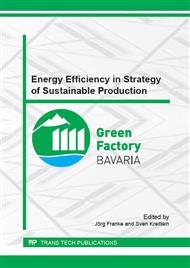[1]
D. Rietzel: Werkstoffverhalten und Prozessanalyse beim Laser-Sintern von Thermoplasten, Dissertation (2011).
Google Scholar
[2]
W. Kaddar: Die generative Fertigung mittels Laser-Sintern: Scanstrategien, Einflüsse verschiedener Prozess-parameter auf die mechanischen und optischen Eigenschaften beim LS von Thermoplasten und deren Nachbearbeitungsmöglichkeiten, Dissertation, (2010).
Google Scholar
[3]
D. Rietzel, E. Schmachtenberg, et al.: Neue Kunststoffpulver für das Selektive Lasersintern, Kunststoffe, Carl Hanser Verlag, München, 2/(2008).
Google Scholar
[4]
S. Singh, A. Sachdeva, V.S. Sharma: Investigation of Dimensional Accuracy/Mechanical Properties of Part Produced by Selective Laser Sintering, International Journal of Applied Science and Engineering, 10, 1, 2012, pp.59-68.
Google Scholar
[5]
K. Wudy, D. Drummer, F. Kühnlein, et al.: Influence of degradation behavior of polyamide 12 powders in laser sintering process on produced part, AIP Conference Proceedings 1593, 691, (2014).
DOI: 10.1063/1.4873873
Google Scholar
[6]
S. Berretta, O. Ghita, K. E. Evans, et al.: Size, Shape and Flow of powders for use in Selective Laser Sintering (SLS, Proceedings of the 6th International Conference on Advanced Research and Rapid Prototyping, VR@P, Leira, Portugal, 2013, pp.49-54.
DOI: 10.1201/b15961-11
Google Scholar
[7]
J.P. Kruth, G. Levy, F. Klocke, et al.: Consolidation phenomena in laser and powder-bed based layered manufacturin, CIRP Annals - Manufacturing Technology Volume 56, Issue 2, 2007, pp.730-759.
DOI: 10.1016/j.cirp.2007.10.004
Google Scholar
[8]
A. Wegner, G. Witt: Ursachen für eine mangelnde Reproduzierbarkeit beim Laser-Sintern von Kunststoff-bauteile, RTejournal, Issue 10, (2013).
Google Scholar
[9]
Y. Tang, H. T. Loh, J. Y. H. Fuh, et al.: Accuracy Analysis and improvement for Direct Laser Sintering, MIT Libraries.
Google Scholar
[10]
A. Wegner, G. Witt: Design rules for laser sintering, Journal of Plastics Technology, Issue 03, (2012).
Google Scholar
[11]
C. C. Seepersad, T. Govett, K. Kim, et al.: A Designer's Guide for Dimensioning and Tolerancing SLS Parts, Solid Freeform Fabrication Symposium, Austin, TX, (2012).
Google Scholar
[12]
R. -J. Wang, L. Wang, L. Zhao, et al.: Influence of process parameters on part shrinkage in SLS, The International Journal of Advanced Manufacturing Technology, Volume 33, Issue 5-6, (2007).
Google Scholar
[13]
N. Raghunath, M. Pulak, Pandey: Improving accuracy through shrink-age modelling by using Taguchi method in selective laser sintering, International Journal of Machine Tools and Manufacture, Volume 47, Issue 6, (2006).
DOI: 10.1016/j.ijmachtools.2006.07.001
Google Scholar
[14]
H. J. Yang, P. J. Hwang, S. H. Lee: A study on shrinkage compensation of the SLS process by using the Taguchi method", International Journal of Machine Tools and Manufacture, Volume 42, Issue 11, (2002).
DOI: 10.1016/s0890-6955(02)00070-6
Google Scholar
[15]
A. Gebhardt, J-S. Hötter, M. Fateri: Generative Fertigungsverfahren, 4. Auflage., Carl-Hanser-Verlag, München, (2007).
Google Scholar
[16]
N. Hopkinson, R. J. M. Hague, P. M. Dickens: Rapid manufacturing - An industrial revolution for the digital age, John Wiley & Sons, Inc., Chichester, England, (2006).
DOI: 10.1002/0470033991.ch1
Google Scholar
[17]
B. Wang: Integrated product, process and enterprise design, Chapman & Hall, London, (1997).
Google Scholar
[18]
S. Kreitlein, A. Höft, S. Schwender, J. Franke: Green Factories Bavaria: A Network of Distributed Learning Factories for Energy Efficient Production. In: 5th Conference on Learning Factories 32(0), S. 58-63, (2015).
DOI: 10.1016/j.procir.2015.02.219
Google Scholar
[19]
S. Freiberger , J. Böhner, S. Kreitlein, R. Steinhilper, J. Franke: Green Factory Bavaria Methodenentwicklung und Wissenstransfer zur Energieeffizienzsteigerung. In: www. elektrotechnik. de - Automation Valley 2012, elektrotechnik, Vogel Media Business Verlag, (2012).
DOI: 10.37544/1436-4980-2012-9-629
Google Scholar
[20]
F. Karl, P. Schnellbach, G. Reinhart, J. Böhner, S. Freiberger, R. Steinhilper, S. Kreitlein, J. Franke, T. Maier, J. Pohl, M. F. Zäh: Green Factory. Bavaria Demonstrations-, Lehr- und Forschungsplattform zur Erhöhung der Energieeffizienz. In: wt Werkstattstechnik online Jahrgang 102 (2012).
DOI: 10.37544/1436-4980-2012-9-629
Google Scholar


